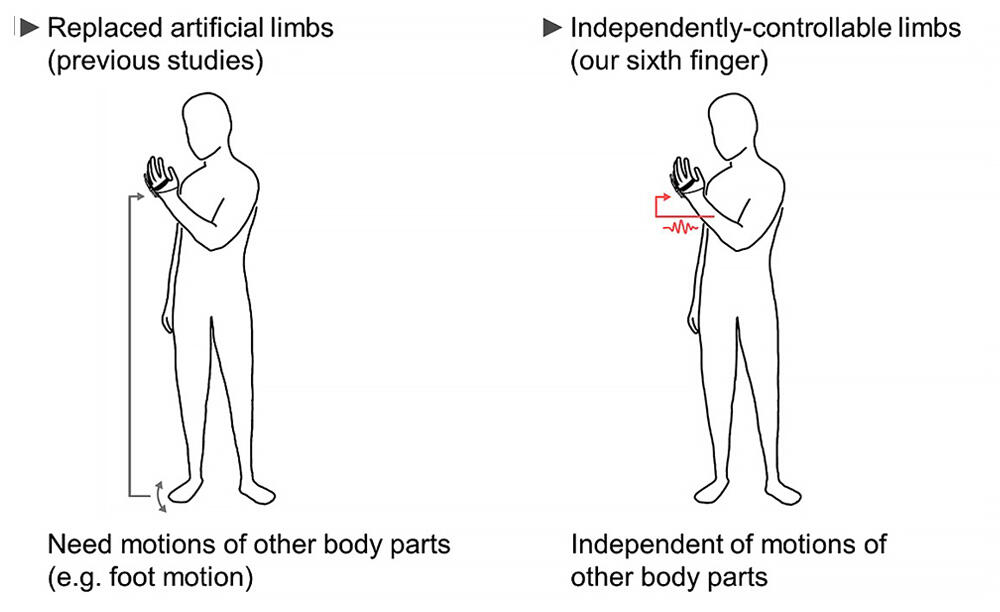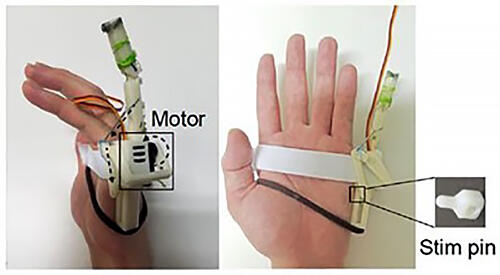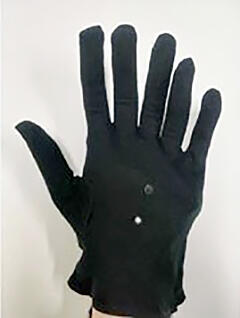Humans have a thumb then index finger, all the way to their little finger... but what would you call the finger that comes next? A Japanese-French international research group, which includes researchers from the University of Electro-Communications, announced that they have developed an artificial finger that is attached to the hand and can be moved independently of any other body parts. Users said that after getting used to this so-called 'sixth finger' via a short practice period, it felt like part of their body. In conventional experiments, movement has been achieved based on the way other body parts move. These experiments showed that it is possible to use a machine to extend a part that the body does not naturally have.
Easily attached next to the little finger
It is said that the brain is flexible when dealing with changes to the body. For example, if someone loses an arm in an accident, they can learn to use a prosthesis. So, if a part that did not originally belong to the body is artificially added, does it feel like it belongs to the user's body, and can they move it freely? To verify this, research has been carried out in which an artificial arm or finger was attached to the body and moved. However, these studies only substituted the movement of one specific body part with the movement of another - e.g., moving a finger by moving a leg.
But can humans own a new, artificial body part that can be moved independently while retaining the body's natural functions and movements? Would it feel like part of their body, and could it be moved freely? No such study had been carried out to date.

(Provided by the University of Electro-Communications)
Thus, a research group that included Professor Yoichi Miyawaki, who studies neuroscience at the Graduate School of Informatics and Engineering, the University of Electro-Communications, and his colleagues took on the challenge of verifying this. First, they developed an artificial finger - the 'sixth finger' - that can easily be attached to a hand. It is attached as an extra finger on the outside of the little finger. The research group measured the electric signals of the muscles of the forearm using a sensor and created a mechanism through which the motor-driven artificial finger moves when a specific signal pattern, different to the patterns used when the other five digits move, occurs. They found a combination of muscle movements not used when moving the other five digits and applied this to the sixth finger. When a subject moves the artificial finger, a pin touches the hand, and conveys a sense of movement.
18 test subjects attached this device and tried to habituate themselves to it for around an hour, bending and straightening their fingers and tapping keys while they had six fingers.

(Provided by the University of Electro-Communications)
An artificial finger well-adapted to the body
The first outcome was that all of the subjects responded to a subjective questionnaire saying that the artificial finger felt like it belonged to them, and that they had been able to move it intuitively in the way they wished. For comparison, the device was also set up so that it moved randomly, and subjects could not control it. There were significant differences here.
This was also verified using objective data. The subjects were asked to move their hand while avoiding an obstacle, looking at their hand as little as possible as they did so. They did this twice, once before the artificial finger was attached, and once when they had removed the finger after having habituated themselves to it. Based on the subjects' trajectory, the group investigated how the artificial finger settled - i.e., changes in localization in the little finger area.
Kohei Umezawa, who worked on this research as a graduate student and is now a company employee, explained the aims of this experiment. "If the perception of the width of the hand changes due to the learning effects caused by attaching the artificial finger, the movements of the hand avoiding the obstacle will also change. Based on this movement trajectory, we wanted to investigate the mental image of the hand, referencing when it was being moved." The group also carried out an experiment in which they asked subjects to touch the perceived location of a drawn line with their index and little finger. The line was drawn outside of a box in which their hands were positioned.
When this experiment was carried out, people who responded to the subjective questionnaire saying that they had a high level of adaptation to the artificial finger had larger variations in their perception of little finger localization after removing the artificial finger. It is apparent that adapting to the artificial finger caused their image of the little finger area to become ambiguous. The research group judged that this objectively indicated that the artificial finger became perceived as part of the body.
Based on these outcomes, the group succeeded in adapting an artificial part to the body for the first time in the world, having it move freely and independently of other body parts, and understood the changes in perceptions and behavior that accompanied this. This indicated that it is possible for humans to extend the body by artificially incorporating a new part, without interfering with the functions of the original body parts.
The research group was made up of researchers from the University of Electro-Communications and the French National Centre for Scientific Research (CNRS).
The results were published on February 14 in Scientific Reports, a British science journal. The research was part of the ERATO Inami JIZAI Body Project, and received support from the Japan Society for the Promotion of Science's Grants-in-Aid for Scientific Research and the Japan Science and Technology Agency (JST) Strategic Basic Research Programs.
Can it be used to type quickly on a computer keyboard? Or something more...?
The artificial finger is still for experiments and can only be simply bent and extended. The research group believe that strengthening the drive system (for example, the motor) and making it into a 'usable finger' could mean it has the potential to be useful for everyday life in the future, such as enabling people to type quickly on a computer keyboard, making musical expression richer by playing the piano or guitar with six fingers, or holding many wine glasses in one hand. The dream grows. "If we apply this technology, then we might be able to experiment with a third arm or four legs, or even with body parts that humans don't have, such as tails or wings."
However, a simple question or rather anxiety arises here. If you have finally learned to touch-type on a keyboard using five fingers, you would have to relearn from scratch with six fingers. When asked about this, research group member Senior Researcher Gowrishankar Ganesh (robotics, motor neurology) of the French National Centre for Scientific Research replied, "You would definitely need a bit of practice, but after that it would be easy. I think it would make it easier to grasp large items, too."
This research is also interesting in that it investigates changes in the brain when a new part has been assimilated by the body. Professor Miyawaki notes, "Would the brain be able to control wings if humans had them, for example? To what extent can the brain flexibly accept body parts that we do not naturally have? I want to learn the limits of the brain."

(Provided by the University of Electro-Communications)
A future in which people can freely design their body?
This has the possibility to dramatically change social values relating to the body. In his view, "An era may be coming in which we can freely design our bodies because it's convenient, or because it's cool. I think the body will be more free, with individuality and diversity. It will also mean rethinking what 'normal' is."
I recalled a popular manga that I enjoyed as a child. A robot that has travelled from the future to the present day brought gadgets in the form of airplane wings, a tank with a caterpillar track and a submarine-like helmet. It made for a strange story, in which people acquired the functions of these vehicles when they wore the gadgets like accessories.
This research really is about attaching artificial parts to the body and updating it. Even if vehicle accessories are still a pipe dream, I'm excited that a future in which people attach parts in their everyday lives seems to be coming a little closer.
(KUSAKA Takeo, Science Portal Editorial Office)
Original article was provided by the Science Portal and has been translated by Science Japan.




